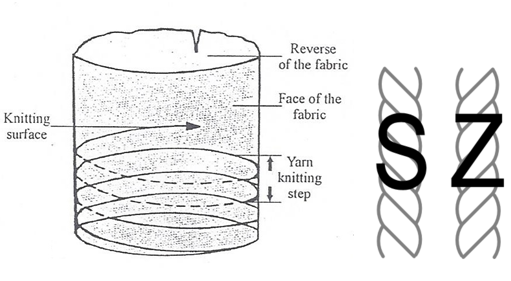The main parameters that are responsible for spirality for knitted fabrics are described below…
The main source of spirality is yarn twist:
When a twisted yarn is knitted into a loop, it will have a tendency to rotate inside the fabric in order to release its torsional strain during relaxation. Unset yarns under low tensile loads have a tendency to return to their untwisted state.
Spirality depends on feed density, machine cut, and loop shape, but the magnitude of spirality can be offset by the selection of yarn twist direction. In addition, reduction in yam “torque” can only partially reduce fabric spirality.

The right use of Z and S twist yarns is essential:
Z-twist yarns make the wales go to the right, giving a Z-skew, and S-twist yarns make the wales go to the left, giving an S-skew to the fabric. In order to minimize spirality, Z-twist yarns should be knitted on machines that rotate clockwise and S-twist yarns should be knitted on machines that rotate counterclockwise.
The number of feeders in a circular knitting machine influences the spirality angle:
Spirality increases strongly when increasing the number of working feeders on the machine. The observed increase of fabric spirality with the number of knitting feeders at a constant machine diameter is due to the nature of weft circular knitting.
The degree of fabric spirality increases linearly with stitch length:
Stitch length expresses the tightness of knitting construction. The fabric is as tight as stitch length is low. The observed proportionality between fabric spirality and stitch length can be explained by the fact that compared to tight fabrics, slack fabrics have higher stitch length and then the yarn composing the loop has a higher tendency to rotate inside the fabric after relaxation. This phenomenon was explained in terms of the ease of freedom of the loop movement in knitted fabric construction. In a more tightly knitted fabric, the movement of a knitted loop is restricted, and thus spirality is reduced.
Spirality also depends on textile dyeing and finishing process.
After wet processing in rope form, the tubular fabric is collapsed and badly twisted. During drying process in relax dryer machines, the fabric is relaxed and the spirality increases.
The control of fabric spirality is a team effort. A knitter contributes by the choice of yarn and stitch length, and a finisher can contribute by the method of finishing he may choose to adopt.
Finishing reduces fabric spirality but a residual spirality angle always remains. Generally a spirality angle under 4° is tolerated before garment confection. As per the experience of world renowned retailers in the globe, seam twisting / shape distortion / spirality greater than 6% in tops and shorts and 4% in skirts, pants, dresses, and sleepwear detracts from the appearance of the garment.
Until today It was very important to reduce fabric spirality from knitting process in order to make spirality correction during finishing possible.
Ref.:
- http://textilelearner.blogspot.com/
- Photo by Engin Akyurt from Pexels

